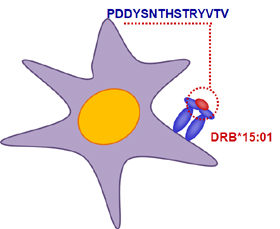Your basket is currently empty!
Finding a way to control chronic CMV infection
Finding a way to control chronic CMV infection
A team at Sanofi Pasteur have used ProImmune’s ProPresent® Antigen Presentation Assay to confirm their discovery of CD4+ T cell epitopes from CMV Glycoprotein B.
Claire Ventura, Hélène Bisceglia, Yves Girerd-Chambaz, Nicolas Burdin and Pascal Chaux. (2012).
HLA-DR and HLA-DP Restricted Epitopes from Human Cytomegalovirus Glycoprotein B Recognized by CD4+ T-Cell Clones from Chronically Infected Individuals. Journal of Clinical Immunology. 32(6): 1305–1316.
Cytomegalovirus (CMV) infection is endemic – between 50 and 80 % of US adults carry the virus. For the majority of these individuals infection is asymptomatic, but there are instances where CMV can pose a serious risk to health. A newly-infected pregnant mother can pass the virus to her unborn baby, which carries a risk of fatality, or long term problems such as hearing loss and learning difficulties for the infant. Immuno-compromised adults are also at risk of organ failure following reactivation of latent CMV. This is a particular problem when a CMV-negative patient receives a CMV-positive bone marrow or organ transplant. In healthy individuals, a surprisingly large portion of the immune system is devoted to keeping CMV infection in check. Over 10% and sometimes up to half of the T cell population of a CMV carrier is CMV-specific, highlighting the pressure on the immune system that this virus exerts.
| A number of studies have suggested that an antibody response to the CMV protein glycoprotein B (gB) is beneficial in terms of controlling infection. This antibody response requires CD4+ T cell help. CD4+ T cell help is known to be essential for control of primary CMV infection, mitigating reactivation of latent infection, and preventing vertical (maternal-fetal) transmission of CMV. However, very little is known about the CMV epitopes that activate a CD4+ T cell response, and so contribute to a protective antibody response.
Claire Ventura and her colleagues at Sanofi Pasteur in France undertook a search for CD4+ epitopes in CMV gB, in order to better understand how a protective antibody response is generated. |

ProImmune’s ProPresent® Antigen Presentation Assay confirmed Sanofi Pasteur’s discovery of a DRB*15:01-restricted epitope from CMV glycoprotein B. |
The team stimulated CD4+ T cells from CMV seropositive donors with autologous antigen-presenting cells (APC) primed with bacterially expressed 60-mer gB polypeptides. Their rationale was that working with a peptide library would be potentially time-consuming, and they wished to restrict analysis to those peptides which are presented by APC in vivo. They confirmed the gB reactivity of their clones using IFNɣ ELISpot, and isolated 15-residue epitopes in a second round of screening using smaller expressed fragments. Four CD4+ T cell epitopes were identified. Through using anti- HLA-DR, DP or DQ neutralizing antibodies, and with knowledge of their donor’s HLA types, the team narrowed down the HLA alleles presenting each epitope. Three epitopes were DP-restricted, while one (PDDYSNTHSTRYVTV) was presented by HLA-DR*07:01.
Sanofi Pasteur then used ProImmune’s ProPresent® Antigen Presentation Assay to confirm the presentation of PDDYSNTHSTRYVTV by HLA-DR*07:01. ProPresent® is an even more direct approach to epitope identification than bacterial expression of protein fragments, taking just weeks to accomplish and obviating the need for a separate analysis of HLA restriction. The Sanofi team sent CMV gB across to ProImmune. We incubated the protein with HLA-DR*07:01 donor-derived dendritic cells, to allow for natural antigen processing and presentation. We then isolated the HLA-DR-peptide complexes and analysed the DR-associated peptides by Mass Spectrometry, coming up with a nested set of peptides centred on the PDDYSNTHSTRYVTV sequence.
The clear identification of epitopes from CMV gB will be useful in several areas of CMV research, going forward. Firstly, it will make tracking of gB-specific CD4+ T cell responses easier in patients experiencing either new CMV infections or reactivation of existing dormant virus. In vaccination research, the ability to monitor how anti-CMV responses might be augmented by a gB-based vaccine (an idea that is receiving some attention) is an exciting prospect.
